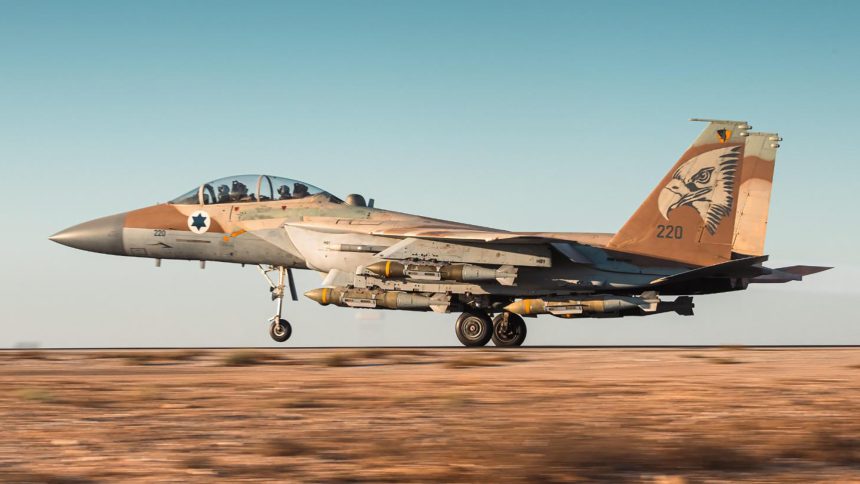F-15I, GBU-31 Bunker-Buster Bombs, and Nasrallah: Israel’s High-Stakes Airstrike.
In a landmark operation, nicknamed “New Order”, the Israeli Air Force employed its F-15I Ra’am jets equipped with GPS-aided GBU-31(V)3/B JDAM bunker-buster bombs in a precision strike targeting Hezbollah leader Hassan Nasrallah on Sept. 27, 2024. The attack, reportedly executed by the 69th Squadron from Hatzerim Airbase, dealt a major blow to Hezbollah by destroying its underground command center in the Dahiyeh suburb of Beirut, Lebanon. Multiple bombs were used, penetrating deep into Hezbollah’s fortified bunkers.
The airstrike, part of Israel’s ongoing military campaign against Hezbollah, is a major escalation in the regional conflict that has paralleled the war against Hamas in Gaza. Nasrallah’s death was confirmed by Hezbollah and has left the Iran-backed group reeling. His assassination marks a significant turning point, as Hezbollah had been heavily involved in cross-border operations against Israel following the October 7 Hamas attack.
Hassan Nasrallah will no longer be able to terrorize the world. pic.twitter.com/gBWxK9FW2F
— Israeli Air Force (@IAFsite) September 28, 2024
According to the Times of Israel military correspondent Emanuel Fabian, senior Israeli Air Force (IAF) officials have confirmed that the airstrike which killed Hezbollah leader Hassan Nasrallah in Beirut proceeded flawlessly, without any mishaps or anti-aircraft fire targeting the Israeli jets. Lt. Col. “Mem,” who leads the IAF’s 69th Squadron, emphasized that “everything went smooth,” including intelligence, planning, and the operation itself. The squadron, operating F-15I fighter jets from Hatzerim Airbase in southern Israel, was tasked with targeting Hezbollah’s underground headquarters in the Dahiyeh neighborhood of Beirut.
“We went to strike in the heart of Beirut, in the Dahiyeh. We knew who we wanted to target,” said Lt. Col. “Mem,” highlighting the precision and intent behind the operation. The strike was part of a broader campaign of Israeli airstrikes in Lebanon aimed at Hezbollah leaders, and Nasrallah’s assassination is seen as a major blow to the Iran-backed militant group.
Brig. Gen. Amichai Levin, the commander of Hatzerim Airbase, described the operation as “very complex” and explained that it had been planned well in advance. He noted that Nasrallah’s death “will have a profound effect that will change the face of the Middle East.”
Additionally, Levin emphasized that the mission was carried out with no risks to Israeli personnel, as no enemy missiles were fired at the jets. He explained that the operation was executed with precision to ensure success, saying, “Dozens of munitions hit the target within seconds with very high precision, and this is part of what is required to hit underground sites at this depth.”
The airstrike, involving multiple F-15I jets equipped with U.S.-made 2,000-pound bombs, demonstrated Israel’s advanced capabilities in targeting fortified underground structures, specifically Hezbollah’s deep underground bunkers in the dense urban area of Beirut.
Images released by the Israeli Air Force show eight F-15I jets each loaded with seven GBU-31 precision-guided munitions. It’s not clear how many of those aircraft were eventually used in the air strike (as some may have been acting as spares) but their loadout is still impressive. The powerful GBU-31 JDAMs (Joint Direct Attak Munitions) are GPS-aided inertially guided bombs designed to penetrate hardened underground structures or concrete shelters. The Guidance and Control Unit (GCU) containing a HG1700 RLG, GEM-III GPS receiver and computer package is installed inside the bomb tailkit. The GCU is used on the bunker busting 2,000-lb class BLU-109/B forged steel penetrator warhead.
🇮🇱 An IAF F-15I assigned to 69 Squadron “The Hammers” taking off from Hatzerim Air Force Base. The strike fighter is seen armed with seven 2,000-pound class GPS-aided GBU-31(V)3/B series JDAMs.
Video link:https://t.co/cBbVhFWnAA https://t.co/eN6H2B6AcI pic.twitter.com/oz9xNTgMGX
— Guy Plopsky (@GuyPlopsky) September 28, 2024
The Israeli GBU-31s caused catastrophic damage, creating craters up to 30 meters deep and killing over 20 Hezbollah operatives, including Nasrallah’s second-in-command, Ali Karaki.
Israelis attacks in Dahiyeh, Beirut, using 85 bunker buster bombs from F-15I planes, causing a big crater and removing remains from a Hezbollah bunker.#Hassan_Nasrallah #Nasrallah#Isreal #Iran pic.twitter.com/QCW86Cqs3c
— Sandeep Raj (@SandeepRaj65) September 29, 2024
This highly advanced munition underscores the technological superiority of the Israeli Air Force in executing precision strikes against hardened targets.
53 meters. That’s the distance between a @UN school and Hezbollah’s underground headquarters where Hassan Nasrallah was eliminated alongside 20+ additional terrorists.
This past Friday, the Israeli Air Force carried out a precise airstrike, directed by the Intelligence… pic.twitter.com/dJaIN4HO58
— Israeli Air Force (@IAFsite) September 29, 2024
Escalating Conflict
Israel’s strike on Nasrallah follows two weeks of intense clashes with Hezbollah, involving airstrikes and rocket fire. Hezbollah has maintained a parallel campaign to the fighting in Gaza, targeting northern Israel, which prompted a sharp response from the Israeli Defense Forces (IDF). This strike is part of a broader Israeli strategy to weaken Hezbollah’s operational capabilities and disrupt its leadership structure, with significant regional implications for Iran and other militant factions aligned with Hezbollah.
The killing of Nasrallah is a significant blow to Hezbollah and its Iranian backers, who have heavily invested in the group’s operational power. Nasrallah, known for his strategic acumen and central role in Hezbollah’s growth, was not only a military leader but also a political figure deeply embedded in Lebanon’s power structure. His death has already sparked strong reactions from Hezbollah supporters, while Iran has vowed retaliation.
By eliminating Nasrallah, Israel not only weakened Hezbollah but also sent a clear message to Iran and its proxies in the region: its high-value targets are not beyond reach. The coming weeks will likely see increased tensions and potential retaliatory actions, making the situation in Lebanon and the broader Middle East highly volatile.









